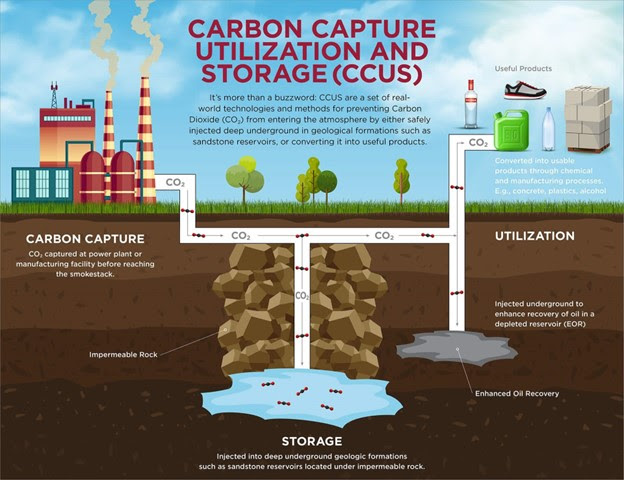- Air Homepage
- Alberta Air Quality
- Prevention of Air Pollution
- Carbon Capture Storage and Utilization
Carbon Capture Storage And Utilization Fights Climate Change & Keeps Jobs.
We're here for your Carbon Capture Storage and Utilization Air Safety needs. - You're building the future with carbon capture, but one air-risk could end it. Our world-class modelling wins approvals and protects lives in days.
 See how it works
See how it worksCarbon capture, utilization, and storage (CCUS) is a suite of technologies designed to capture carbon dioxide (CO2) emissions from industrial sources, transport them, and either use them (like in oil recovery and manufacturing) or store them permanently underground in geological formations. In hard-to-decarbonize sectors like oil sands, power generation, cement, steel, and petrochemicals, this approach is a key tool. The government of Alberta, Canada, promotes carbon capture storage and utilization as safe and effective for reducing emissions while leveraging the Western Canadian Sedimentary Basin's geology.
Here's how CCUS works
Typically, there are three steps:
- In industrial facilities, CO2 is captured using methods like absorption with solvents (e.g., amines), membranes, and direct air capture.
- CO2 is transported via pipelines to storage or utilization.
- Storage/Utilization: CO2 is injected deep underground (often more than 1 km) into porous rock formations, where it can stay trapped for millions of years, just like oil and gas. It might be injected for Enhanced Oil Recovery (EOR) or converted into concrete or fuel.
Carbon Capture Storage and Utilization: Environmental Safety in Alberta
Since the 1970s, more than 300 million tonnes of CO2 have been captured and stored globally, with projects like Quest and the Alberta Carbon Trunk Line storing more than 14 million tonnes.
 Carbon Capture systems - schematic
Carbon Capture systems - schematicOfficial Alberta sources say CCUS is highly regulated to protect the environment. There are a few key elements:
- Geology: Storage targets rock formations that have held fossil fuels for millennia, with capillary trapping, dissolution, and mineralization ensuring permanence. It's good to pick sites that won't impact freshwater, soil, or plants.
- AER enforces one of the world's most advanced systems, requiring approvals for capture, transport, injection, and storage. It's important to follow laws like the Mines and Minerals Act, Oil and Gas Conservation Act, Water Act, and Environmental Protection and Enhancement Act. It's impossible to advance a project without attention to safety.
- Monitoring, Measurement, and Verification (MMV): Comprehensive plans track CO2 before, during, and after injection (for decades after closure). Subsurface CO2 movement is monitored, near-surface leaks in soil/groundwater are checked, and atmospheric CO2 levels are assessed. It's mandatory to have closure plans and certificates.
- In 2022, Alberta will select 25 storage hub proposals for safe, strategic deployment through competitive processes. AER approves these, but they're overseen by private operators.
- The province has invested over $1.8 billion in carbon capture storage and utilization, considering it critical to net-zero goals, clean hydrogen, and economic diversification. MMV requirements are outlined in AER Directive 065.
There's no impact on water, land, or air, according to the government, and research shows CO2 stays contained. As proof of safety, they point to global deployments seen in places like Norway, the U.S., and Australia.
Benefits for the Environment
CCUS supporters say it's essential:
- Assists Canada's targets (e.g., 40-45% reduction by 2030) by reducing CO2 emissions from point sources by up to 90%.
- Bioenergy with Carbon Capture and Storage (BECCS) results in negative emissions.
- Ensures energy security and low-carbon products like hydrogen.
- It uses less land than renewables, and can create jobs in places like Alberta.
It would be hard to meet global emission targets without carbon capture storage and utilization, says the International Energy Agency (IEA). By preventing CO2 emissions, it can lower overall environmental impacts in energy systems.
Environmental Risks and Criticisms
In spite of assurances, CCUS faces scrutiny from environmental groups, scientists, and independent analyses. Here are some key concerns:
 Not exactly beautiful, but trying to improve...
Not exactly beautiful, but trying to improve...- CO2 leakage can happen because of seismic activity, well failures, or poor site selection, contaminating groundwater, acidifying soil, or releasing CO2 into the atmosphere. Climate benefits could be undermined by even small leaks (e.g., 0.1-1% over decades). There are risks associated with offshore storage, like ocean acidification. Asphyxiation in populated areas is a danger highlighted by historical incidents like CO2 releases from pipelines.
- Impacts on health and the environment: Amine-based capture can produce harmful byproducts (e.g., nitrosamines, nitramines) if not managed. By competing for land, BECCS variants threaten biodiversity, water security, and food systems. Overburdened communities are at risk of explosions or leaks caused by pipelines.
- Capture processes use 10-40% more energy, increasing fossil fuel use and indirect emissions. Some methods use a lot of water.
- Perpetuating Fossil Fuels: Critics say carbon capture storage and utilization delays the transition from fossil fuels, allowing oil/gas companies to keep operating under a "green" guise, especially in Alberta's oil sands. If leaks happen or if it's used for EOR (which extracts more fossil fuels), it might not reach net-zero.
- Economic and Scalability Issues: High costs (upfront investments in the billions) and slow deployment limit impact. Most CO2 captured is used for EOR, not permanently stored.
Despite Alberta's stringent regulations, some note inconsistencies between federal and provincial rules and risks related to seismic activity or aging infrastructure. Fossil fuel-heavy areas face amplified threats, say environmental NGOs.
An Overall Assessment
Carbon capture storage and utilization offers a viable path for emissions reductions in Alberta and around the world, backed by decades of operational data. However, independent sources say it's leaking, causing health problems, and prolonging fossil fuel dependence. Transparent monitoring, site-specific assessments, and integration with broader decarbonization strategies are key to success.
AER oversight provides reassurance for Alberta projects, but stakeholders should review independent audits and global case studies to get a full picture. For technical guidance, check out the Global CCS Institute or IEA.
Clean air is our Passion...Regulatory Compliance is our Business.
Carbon capture, storage, and utilization (CCUS) is a game-changer for emissions. But what about nitrosamines, nitramines, and NDMA from amine capture? A precise ADMS 6 dispersion modelling assessment is required. To protect health and secure approvals, regional impacts must remain below 0.3 ng/m3. Your urgency is felt by us.
Barry here at Calvin Consulting Group Ltd. Three of our five Principal Consultants bring numerous years of combined experience to the table. AEPA, AER, and Environment Canada teams were trained by us in the past. Our depth is unmatched in Canada.
Our delivery time is fast. Using AERMET/CALMET, we create five-year site-specific meteorology, integrate terrain, and can also model the right sources using ADMS 6. We make reports with tables, graphics, and compliance proof ready for regulators. There are no delays. Stress-free.
It is vital for the environment. Smart economics. Clean data is essential to the success of your CCUS project. It's effortless with us. Email...
...now. Together, let's protect the air, win approvals, and lead the way forward.
The CCUS in Alberta captures CO2 from oil sands and industries and stores it underground.
Over 50 years and 300M tonnes stored, projects like have safely sequestered 14M tonnes since 2015. A rigorous Alberta Energy Regulator oversight, extensive monitoring, and ideal geology ensure no impact on water or soil. CCUS invests $1.8B in hard-to-abate sectors. Climate targets can be met with proven, regulated, and essential carbon capture, storage, and utilization.
Do you have concerns about air pollution in your area??
Perhaps modelling air pollution will provide the answers to your question.
That is what I do on a full-time basis. Find out if it is necessary for your project.
Have your Say...
on the StuffintheAir facebook page
Other topics listed in these guides:
The Stuff-in-the-Air Site Map
And,
Thank you to my research and writing assistants, ChatGPT and WordTune, as well as Wombo and others for the images.
OpenAI's large-scale language generation model (and others provided by Google and Meta), helped generate this text. As soon as draft language is generated, the author reviews, edits, and revises it to their own liking and is responsible for the content.


New! Comments
Do you like what you see here? Please let us know in the box below.